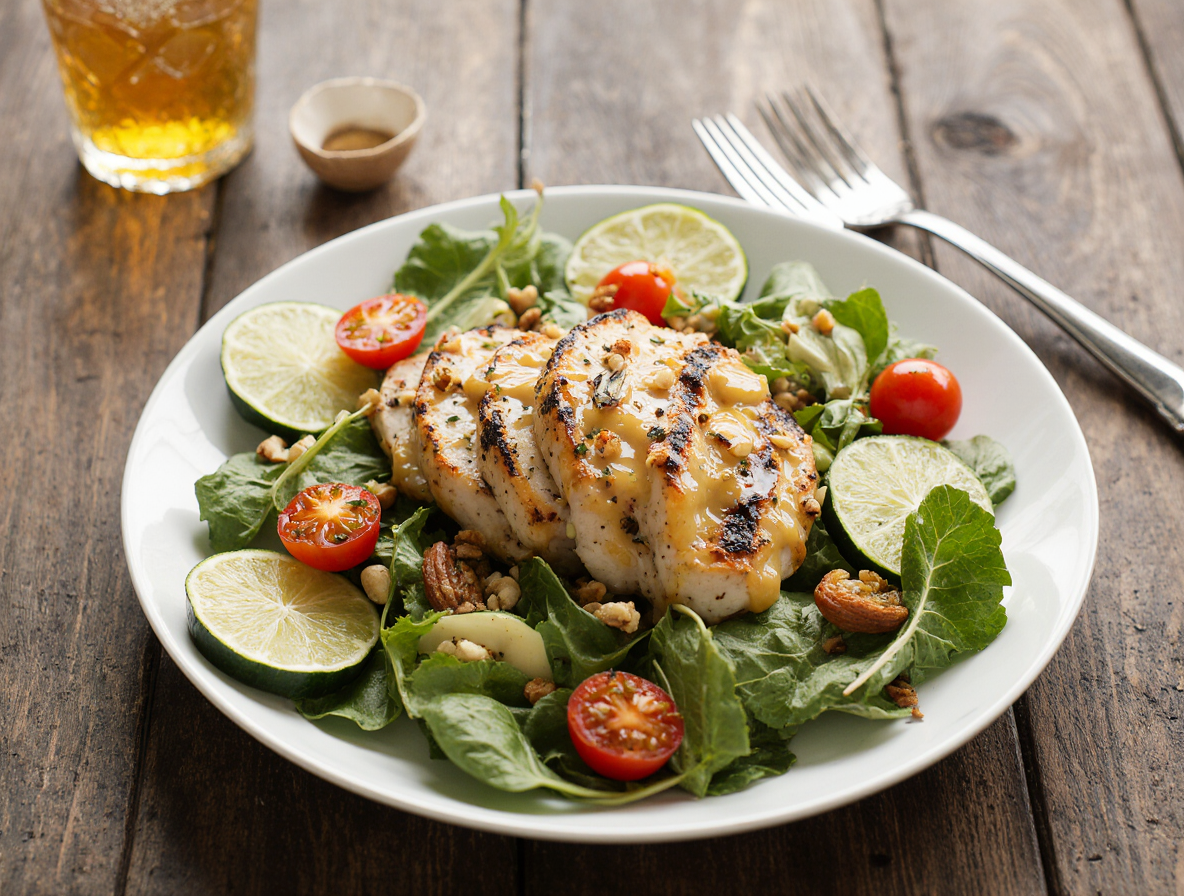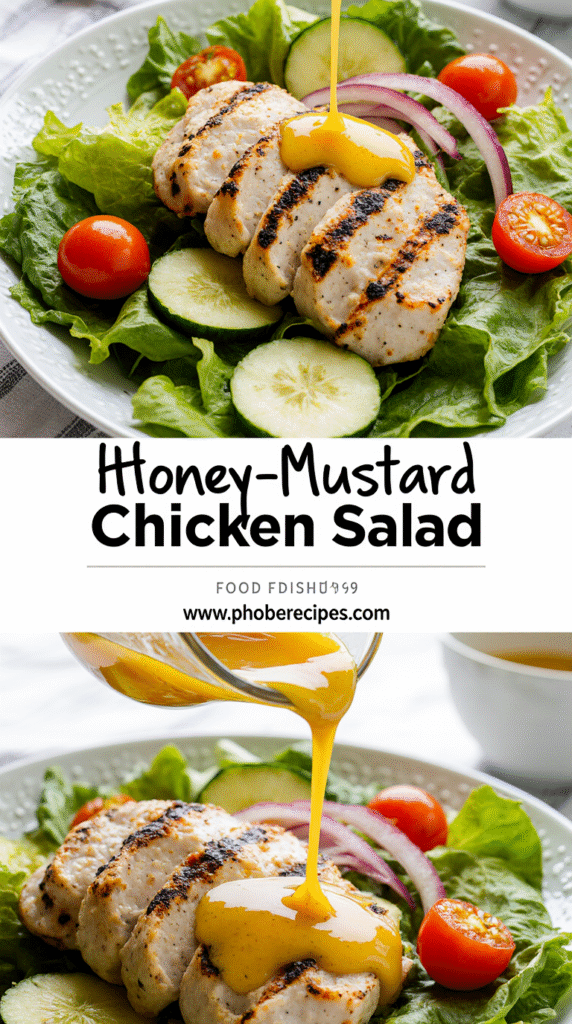How to Make Restaurant-Style Honey Mustard Chicken Salad (Chef’s Secrets)
Honey mustard chicken salad was the #1 chicken salad recipe on Pinterest and Facebook for all of 2016 and 2017 – and it’s easy to see why this dish has earned such massive popularity!
Not only does this satisfying salad provide 27 grams of high-quality protein per serving, but it also comes together in just 10 minutes total time. The secret lies in the incredible honey mustard dressing that actually doubles as both the marinade and dressing, creating deliciously crispy, golden edges on the chicken. Furthermore, this versatile crispy chicken salad is packed with fresh diced tomatoes, crunchy bacon, and avocado, making it perfect for wraps, flatbreads, on rolls, or scooped on top of greens.
In this article, we’ll reveal all the chef’s secrets to creating the perfect honey mustard chicken salad recipe at home. From balancing the creamy, tangy dressing with just the right touch of sweetness to mastering the cooking techniques that ensure juicy, flavorful chicken every time. Whether you’re looking to make a honey mustard chicken salad sandwich or meal prep for the week ahead, these professional tips will elevate your salad game to restaurant quality.
Make the Perfect Honey Mustard Dressing
The secret to a restaurant-quality honey mustard chicken salad begins with a perfectly balanced dressing. Unlike store-bought versions, homemade honey mustard delivers vibrant flavors that elevate your salad from ordinary to extraordinary.
Key ingredients for balance
Creating a balanced honey mustard dressing requires just a handful of quality ingredients. Dijon mustard serves as the foundation, providing a smooth, creamy texture and well-rounded flavor that yellow or stone ground mustards can’t match. Honey adds essential sweetness while apple cider vinegar (or fresh lemon juice) introduces the necessary tang.
A good-quality extra virgin olive oil gives the dressing body and silky richness. For depth and complexity, a minced garlic clove works wonders. Optional seasonings like salt, pepper, smoked paprika, or a pinch of cayenne can further enhance the flavor profile.
The magic happens when these elements harmonize—the sweet honey balances the sharp mustard, while the acid from vinegar brightens everything up. This creates a dressing that’s neither too sweet nor too tangy, making it perfect for both marinating and dressing.
How to use it as both marinade and dressing
One of the greatest advantages of homemade honey mustard is its versatility as both marinade and dressing. When using as a marinade, simply reserve half the batch for your salad dressing. For chicken, marinate for at least 4 hours but up to 8 hours for maximum flavor penetration.
Because this honey mustard marinade is relatively low in acidity, you can safely marinate chicken or pork for 12-24+ hours for deeper flavor development. For seafood, limit marinating time to 1-6 hours.
Once your protein is cooked, the reserved dressing can be drizzled over your assembled salad, creating a harmonious flavor profile throughout the entire dish.
Tips for adjusting sweetness and tang
The perfect honey mustard dressing is highly customizable. If you find your dressing too sweet, add more vinegar or mustard to balance it out. Conversely, if it’s too sharp or tangy, an extra drizzle of honey will mellow the flavor.
Keep in mind that honey varieties significantly impact flavor—local raw honey often delivers superior taste. Additionally, mustard brands vary in saltiness and tang, so always taste as you go.
For a thinner, more pourable consistency ideal for salads, whisk in a splash of water or extra vinegar. If you prefer a creamier dressing, some recipes incorporate mayonnaise or Greek yogurt for added richness.
Store your honey mustard dressing in an airtight container in the refrigerator, where it will keep fresh for up to 3 weeks, allowing the flavors to marry and develop even further.
Cook the Chicken Like a Chef
Perfectly cooked chicken is the foundation of an exceptional honey mustard chicken salad. I’ve discovered that the cooking method you choose can dramatically alter the final result of your dish.
Grilled vs. crispy chicken options
For a lighter, smoky flavor profile, grilled chicken works beautifully. Simply preheat your grill to medium heat, season the chicken with salt and pepper, then cook for approximately 5-6 minutes per side until the internal temperature reaches 165°F. Alternatively, crispy chicken adds delightful texture contrast. To achieve this, dredge chicken in flour seasoned with salt and pepper, dip in beaten egg, then coat with panko and parmesan mixture. Cook in hot oil for 4-5 minutes per side until golden brown.
How to marinate for maximum flavor
Marinating is essential for flavor-packed chicken. Ideally, allow chicken to marinate in your honey mustard mixture for 30 minutes to 2 hours. Nevertheless, since this marinade doubles as dressing, even a quick 15-minute soak will enhance flavor. For meal planning, you can freeze marinated chicken for up to 3 months. When ready to cook, thaw overnight in the refrigerator.
Secrets to juicy, golden chicken every time
The cut of chicken matters significantly. Chicken thighs generally yield more tender, juicy results, though breasts can be excellent when properly prepared. If using breasts, pound them to an even ¼-inch thickness or cut them in half widthwise before marinating.
For foolproof juicy chicken breasts, try this chef-approved method: heat a pan over medium-high, add oil, and sear chicken for just 1 minute. Flip, reduce heat to low, cover, and cook for 10 minutes. Then turn off heat, leave covered for another 10 minutes without peeking. This gentle cooking method prevents dryness.
During cooking, resist the urge to repeatedly flip the chicken – once is enough. After cooking, allow chicken to rest for 5-10 minutes before slicing. This crucial step lets juices redistribute throughout the meat, ensuring perfectly moist chicken for your salad.
Assemble the Ultimate Chicken Honey Mustard Salad
Building the perfect honey mustard chicken salad requires thoughtful layering and ingredient selection. The assembly process transforms individual components into a harmonious dish with balanced flavors and textures.
Choosing the right greens and veggies
Start with a sturdy lettuce base—romaine is particularly ideal as it holds up well under toppings and dressing. Alternatively, try spinach, kale, or arugula for different flavor profiles.
In terms of vegetables, aim for vibrant color variety. Cherry tomatoes provide juicy acidity, while cucumber adds refreshing crunch. Avocado contributes essential creaminess, alongside sweet corn kernels for natural sweetness and texture. Red onion delivers a peppery tang that complements the honey mustard perfectly.
Layering for texture and flavor
First, place chopped greens in a large bowl or platter. Notably, cutting all ingredients into bite-sized pieces creates the perfect eating experience. Next, arrange vegetables atop the greens before adding your warm sliced chicken.
For optimal results, drizzle dressing a little at a time while gently tossing. This ensures even distribution without overwhelming the salad.
Optional toppings: bacon, eggs, nuts, and more
Crispy bacon adds irresistible smokiness and texture. Hard-boiled eggs provide extra protein and richness. Moreover, nuts offer satisfying crunch—try sliced almonds, chopped cashews, or toasted pecans.
For added complexity, consider crumbled feta or shredded cheddar, seasonal fruits like strawberries, or even croutons for extra crunch. With these elements properly combined, your honey mustard chicken salad achieves restaurant-quality excellence.
Serving and Customizing Like a Pro
Once you’ve mastered the basic honey mustard chicken salad, transforming it into different meal formats opens up endless possibilities for enjoying this versatile dish throughout the week.
How to turn it into a honey mustard chicken salad sandwich
The ultimate honey mustard chicken salad sandwich requires the right bread. Croissants reign supreme, their buttery, flaky texture perfectly complementing the creamy-tangy filling. Alternatively, brioche or Hawaiian bread offers delightful sweetness. For assembly, first toast your bread lightly, afterward add a layer of lettuce to prevent sogginess, immediately followed by a generous scoop of chicken salad.
Meal prep and storage tips
For efficient meal prep, store components separately—keep the bread, chicken salad filling, and any extras like lettuce in individual containers. When properly stored, honey mustard chicken salad stays fresh in an airtight container for 3-5 days. Throughout busy weeks, prepare a large batch by tripling the recipe with a colossal rotisserie chicken yielding approximately 6 cups of meat. Incredibly, you can even freeze portions for up to 3 months—simply thaw overnight in the refrigerator and stir well before serving.
Creative serving ideas: wraps, bowls, and platters
Beyond sandwiches, transform your honey mustard chicken salad into 10-minute wraps by rolling it in flour tortillas with mixed greens and dried cranberries. Equally appealing, create a party platter with the salad as a centerpiece surrounded by veggie sticks, chips, crackers, and pretzels for dipping. For lighter options, serve atop romaine lettuce with a squeeze of lemon juice and extra toasted nuts.
Conclusion
Mastering the art of restaurant-style honey mustard chicken salad ultimately comes down to attention to detail. Throughout this guide, we’ve uncovered several chef secrets that transform an ordinary salad into a culinary masterpiece. Most importantly, the dual-purpose honey mustard mixture serves as both marinade and dressing, creating incredible flavor while saving preparation time.
Additionally, proper chicken cooking techniques make all the difference between dry, bland meat and juicy, golden perfection. Remember to let your chicken rest before slicing – this simple step ensures moisture stays locked inside rather than running onto your cutting board.
The versatility of this dish certainly stands out as one of its greatest strengths. Whether you prefer a crisp grilled chicken salad, a hearty sandwich on buttery croissants, or convenient meal-prepped wraps, the basic components adapt beautifully to countless variations. You can easily customize toppings based on seasonal availability or personal preference.
After trying this recipe, you’ll likely find store-bought versions pale in comparison. The vibrant flavors and satisfying textures of homemade honey mustard chicken salad make it worth the minimal effort required. Furthermore, the ability to adjust sweetness, tanginess, and creaminess allows you to create your perfect flavor balance.
Next time you crave a restaurant-quality meal without the restaurant price tag, give this honey mustard chicken salad a try. With these professional techniques at your disposal, you’ll create a dish worthy of those viral social media shares that made this recipe so popular in the first place.
FAQs
Q1. How long can I marinate chicken for honey mustard chicken salad? For best results, marinate the chicken for 30 minutes to 2 hours. However, you can marinate it for up to 8 hours for maximum flavor. If you’re short on time, even a quick 15-minute soak will enhance the taste.
Q2. What’s the secret to making a perfectly balanced honey mustard dressing? The key is using quality ingredients like Dijon mustard, honey, apple cider vinegar or lemon juice, and extra virgin olive oil. Adjust the sweetness and tanginess by adding more honey or vinegar as needed. Taste as you go to achieve the perfect balance.
Q3. Can I meal prep honey mustard chicken salad? Absolutely! You can prepare a large batch and store it in an airtight container in the refrigerator for 3-5 days. For longer storage, you can freeze portions for up to 3 months. Just thaw overnight in the fridge and stir well before serving.
Q4. What are some creative ways to serve honey mustard chicken salad? Besides the traditional salad, you can turn it into a sandwich using croissants or brioche bread. You can also make quick wraps using flour tortillas, create a party platter with veggie sticks and crackers for dipping, or serve it in lettuce cups for a low-carb option.
Q5. How do I ensure my chicken stays juicy when cooking for this salad? To keep chicken juicy, avoid overcooking. For chicken breasts, try pounding them to an even thickness or cutting them in half widthwise before cooking. Use a meat thermometer to check for doneness (165°F internal temperature), and always let the chicken rest for 5-10 minutes before slicing to allow juices to redistribute.


